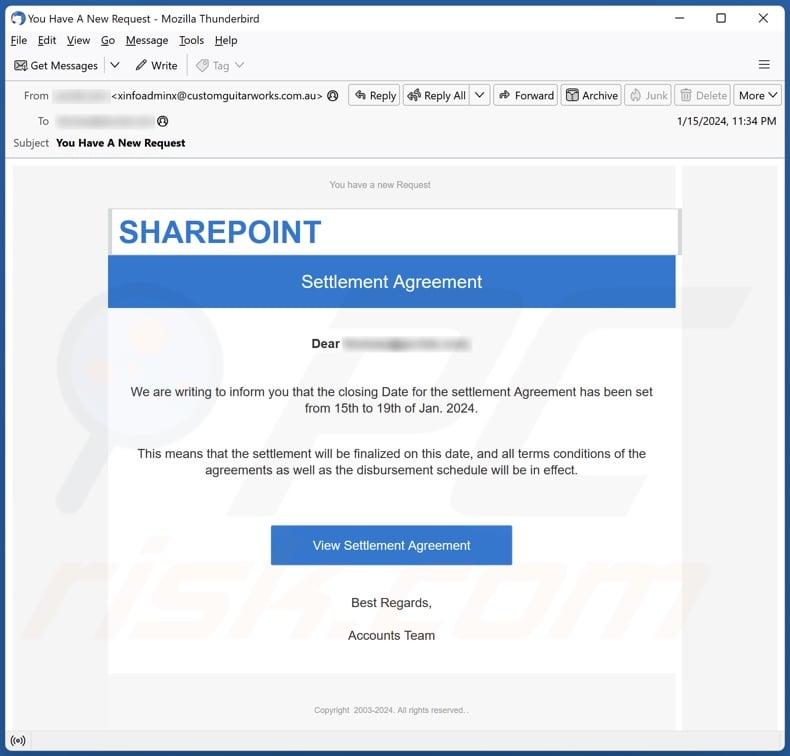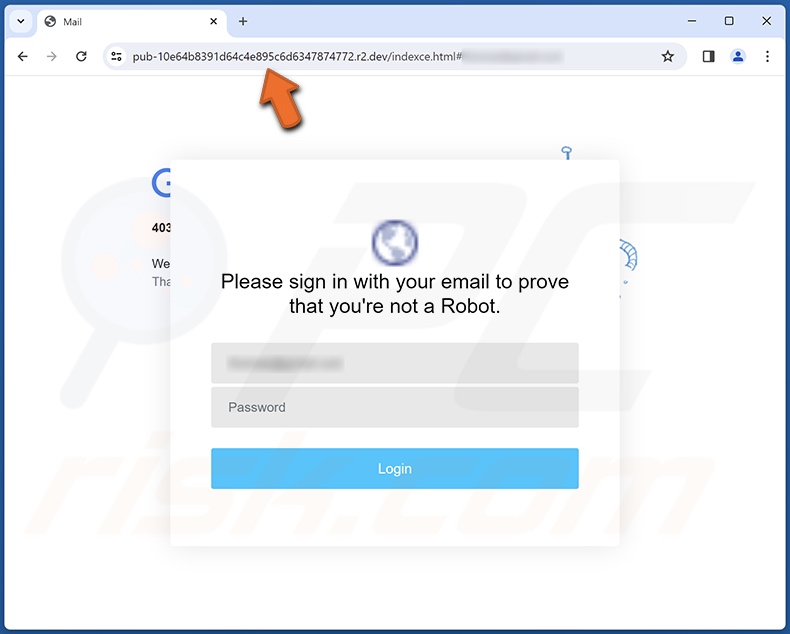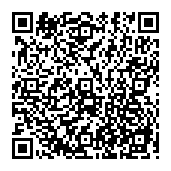Avoid losing your account to fake "SharePoint Settlement Agreement" emails
![]() Written by Tomas Meskauskas on
Written by Tomas Meskauskas on
What kind of email is "SharePoint Settlement Agreement"?
After reviewing the "SharePoint Settlement Agreement" email, we determined that it is spam. The letter is presented as a notification regarding settlement agreement documents sent via SharePoint.
It must be stressed that all the information provided by this email is false, and this mail is not associated with SharePoint. The goal is to deceive recipients into disclosing their email account log-in credentials (passwords) to a phishing website.

"SharePoint Settlement Agreement" email scam overview
The scam email with the subject "You Have A New Request" (may vary) is supposedly a notification from SharePoint. The letter concerns a settlement agreement and lists its date of closing. At the provided time, all the agreement's terms and conditions will come into effect. To review the sent documents, the recipient can click the "View Settlement Agreement" button.
It must be stressed that all information in this email is false, and this mail is not associated with SharePoint or any other legitimate services or entities.
After pressing the button in the letter, the user is redirected to a phishing website. The page requests to provide email account log-in credentials, as a bogus CAPTCHA verification process. This site is fake, and records entered information that is then sent to scammers.
The risk exceeds the loss of an email, as accounts of this kind are used to register other content. Hence, through a compromised email – access/control may be gained over connected accounts and platforms.
To elaborate on the potential misuse, cyber criminals can steal the identities of social account owners (e.g., emails, social networking, social media, chats, etc.) and ask the contacts/friends/followers for loans or donations, promote scams, and spread malware by sharing malicious files/links.
Furthermore, any sensitive/confidential content discovered on compromised data storage or similar platforms could be used for blackmail or other nefarious purposes. What is more, hijacked finance-related accounts (e.g., online banking, money transferring, e-commerce, digital wallets, etc.) can be used to make fraudulent transactions and online purchases.
In summary, by trusting an email like "SharePoint Settlement Agreement" – users may experience serious privacy issues, financial losses, and even identity theft.
If you have already entered your log-in credentials into a phishing website – immediately change the passwords of all potentially exposed accounts and contact their official support.
| Name | "SharePoint Settlement Agreement" phishing email |
| Threat Type | Phishing, Scam, Social Engineering, Fraud |
| Fake Claim | Settle agreement documents were sent via SharePoint. |
| Disguise | SharePoint |
| Symptoms | Unauthorized online purchases, changed online account passwords, identity theft, illegal access of the computer. |
| Distribution methods | Deceptive emails, rogue online pop-up ads, search engine poisoning techniques, misspelled domains. |
| Damage | Loss of sensitive private information, monetary loss, identity theft. |
| Malware Removal (Windows) | To eliminate possible malware infections, scan your computer with legitimate antivirus software. Our security researchers recommend using Combo Cleaner. |
Phishing spam campaign examples
"Alibaba email scam", "DHL Agreement Documents", "Oversea Credit Commission", "Payroll Sheet" – are merely some examples of phishing emails. These letters primarily target log-in credentials (usernames/passwords), personally identifiable details, and finance-related data (e.g., banking account details, credit card numbers, etc.).
Other scams are promoted through spam mail as well, and it is used to distribute malware. It is common for deceptive emails to be full of various errors, yet they may also be competently disguised as messages from legitimate companies, institutions, organizations, authorities, and other entities.
How do spam campaigns infect computers?
Cyber criminals often use spam campaigns to proliferate malware. The emails/messages can include malicious files as attachments or download links. These files come in various formats, e.g., executables (.exe, .run, etc.), archives (RAR, ZIP, etc.), documents (PDF, Microsoft Office, Microsoft OneNote, etc.), JavaScript, and so forth.
Once opened, a virulent file triggers the system infection process. Some formats can require extra actions to begin malware download/installation chains. For example, Microsoft Office files require users to enable macro commands (i.e., editing/content), while OneNote documents need them to click embedded content such as files or links.
How to avoid installation of malware?
We strongly advise exercising caution with incoming emails, DMs/PMs, SMSes, and other messages. Attachments/Links found in suspicious/irrelevant mail must not be opened, as they can be malicious. We recommend using post-2010 Microsoft Office versions since their "Protected View" mode prevents automatic macro execution.
It must be mentioned that malware is not spread exclusively through spam mail. Therefore, we also advise being careful while browsing, as fraudulent and dangerous online content usually appears genuine and harmless.
Additionally, all downloads must be made from official and trustworthy sources. Another recommendation is to activate and update programs using functions/tools provided by legitimate developers, as illegal activation tools ("cracks") and third-party updates may contain malware.
We must emphasize the importance of having a reputable anti-virus installed and kept up-to-date. Security software must be used to perform regular system scans and to remove threats and issues. If you've already opened malicious attachments, we recommend running a scan with Combo Cleaner Antivirus for Windows to automatically eliminate infiltrated malware.
Text presented in the "SharePoint Settlement Agreement" spam email letter:
Subject: You Have A New Request
You have a new Request
SHAREPOINT
Settlement Agreement
Dear -,
We are writing to inform you that the closing Date for the settlement Agreement has been set from 15th to 19th of Jan. 2024.
This means that the settlement will be finalized on this date, and all terms conditions of the agreements as well as the disbursement schedule will be in effect.
View Settlement Agreement
Best Regards,
Accounts Team
Copyright 2003-2024. All rights reserved. .
Screenshot of the phishing website promoted by the "SharePoint Settlement Agreement" spam campaign:

Instant automatic malware removal:
Manual threat removal might be a lengthy and complicated process that requires advanced IT skills. Combo Cleaner is a professional automatic malware removal tool that is recommended to get rid of malware. Download it by clicking the button below:
▼ DOWNLOAD Combo Cleaner
By downloading any software listed on this website you agree to our Privacy Policy and Terms of Use. To use full-featured product, you have to purchase a license for Combo Cleaner. 7 days free trial available. Combo Cleaner is owned and operated by Rcs Lt, the parent company of PCRisk.com read more.
Quick menu:
- What is "SharePoint Settlement Agreement" phishing email?
- Types of malicious emails.
- How to spot a malicious email?
- What to do if you fell for an email scam?
Types of malicious emails:
![]() Phishing Emails
Phishing Emails
Most commonly, cybercriminals use deceptive emails to trick Internet users into giving away their sensitive private information, for example, login information for various online services, email accounts, or online banking information.
Such attacks are called phishing. In a phishing attack, cybercriminals usually send an email message with some popular service logo (for example, Microsoft, DHL, Amazon, Netflix), create urgency (wrong shipping address, expired password, etc.), and place a link which they hope their potential victims will click on.
After clicking the link presented in such email message, victims are redirected to a fake website that looks identical or extremely similar to the original one. Victims are then asked to enter their password, credit card details, or some other information that gets stolen by cybercriminals.
![]() Emails with Malicious Attachments
Emails with Malicious Attachments
Another popular attack vector is email spam with malicious attachments that infect users' computers with malware. Malicious attachments usually carry trojans that are capable of stealing passwords, banking information, and other sensitive information.
In such attacks, cybercriminals' main goal is to trick their potential victims into opening an infected email attachment. To achieve this goal, email messages usually talk about recently received invoices, faxes, or voice messages.
If a potential victim falls for the lure and opens the attachment, their computers get infected, and cybercriminals can collect a lot of sensitive information.
While it's a more complicated method to steal personal information (spam filters and antivirus programs usually detect such attempts), if successful, cybercriminals can get a much wider array of data and can collect information for a long period of time.
![]() Sextortion Emails
Sextortion Emails
This is a type of phishing. In this case, users receive an email claiming that a cybercriminal could access the webcam of the potential victim and has a video recording of one's masturbation.
To get rid of the video, victims are asked to pay a ransom (usually using Bitcoin or another cryptocurrency). Nevertheless, all of these claims are false - users who receive such emails should ignore and delete them.
How to spot a malicious email?
While cyber criminals try to make their lure emails look trustworthy, here are some things that you should look for when trying to spot a phishing email:
- Check the sender's ("from") email address: Hover your mouse over the "from" address and check if it's legitimate. For example, if you received an email from Microsoft, be sure to check if the email address is @microsoft.com and not something suspicious like @m1crosoft.com, @microsfot.com, @account-security-noreply.com, etc.
- Check for generic greetings: If the greeting in the email is "Dear user", "Dear @youremail.com", "Dear valued customer", this should raise suspiciousness. Most commonly, companies call you by your name. Lack of this information could signal a phishing attempt.
- Check the links in the email: Hover your mouse over the link presented in the email, if the link that appears seems suspicious, don't click it. For example, if you received an email from Microsoft and the link in the email shows that it will go to firebasestorage.googleapis.com/v0... you shouldn't trust it. It's best not to click any links in the emails but to visit the company website that sent you the email in the first place.
- Don't blindly trust email attachments: Most commonly, legitimate companies will ask you to log in to their website and to view any documents there; if you received an email with an attachment, it's a good idea to scan it with an antivirus application. Infected email attachments are a common attack vector used by cybercriminals.
To minimise the risk of opening phishing and malicious emails we recommend using Combo Cleaner Antivirus for Windows.
Example of a spam email:

What to do if you fell for an email scam?
- If you clicked on a link in a phishing email and entered your password - be sure to change your password as soon as possible. Usually, cybercriminals collect stolen credentials and then sell them to other groups that use them for malicious purposes. If you change your password in a timely manner, there's a chance that criminals won't have enough time to do any damage.
- If you entered your credit card information - contact your bank as soon as possible and explain the situation. There's a good chance that you will need to cancel your compromised credit card and get a new one.
- If you see any signs of identity theft - you should immediately contact the Federal Trade Commission. This institution will collect information about your situation and create a personal recovery plan.
- If you opened a malicious attachment - your computer is probably infected, you should scan it with a reputable antivirus application. For this purpose, we recommend using Combo Cleaner Antivirus for Windows.
- Help other Internet users - report phishing emails to Anti-Phishing Working Group, FBI’s Internet Crime Complaint Center, National Fraud Information Center and U.S. Department of Justice.
Frequently Asked Questions (FAQ)
Why did I receive this email?
Despite any relevant details that spam emails may contain, they are not personal. Cyber criminals distribute this mail in large-scale campaigns – therefore, thousands of users receive identical messages.
I have provided my personal information when tricked by this spam email, what should I do?
If you have provided your account credentials – change the passwords of all possibly compromised accounts and inform their official support without delay. And if the disclosed information was of a different personal nature (e.g., ID card details, credit card numbers, etc.) – immediately contact relevant authorities.
I have read a spam email but didn't open the attachment, is my computer infected?
Devices are infected when malicious attachments or links are opened/clicked; merely reading an email is harmless.
I have downloaded and opened a file attached to a spam email, is my computer infected?
Whether your device was infected might depend on the format of the opened file. If it was an executable (.exe, .run, etc.) – it is highly likely that the system was compromised. However, you might have avoided triggering an infection if it was a document (.doc, .xls, .one, .pdf, etc.). These formats can require additional user interaction to jumpstart malware download/installation processes (e.g., enabling macro commands, clicking embedded files/links, etc.).
Will Combo Cleaner remove malware infections present in email attachments?
Yes, Combo Cleaner can detect and eliminate nearly all known malware infections. It must be stressed that running a complete system scan is paramount since sophisticated malicious programs typically hide deep within systems.


▼ Show Discussion